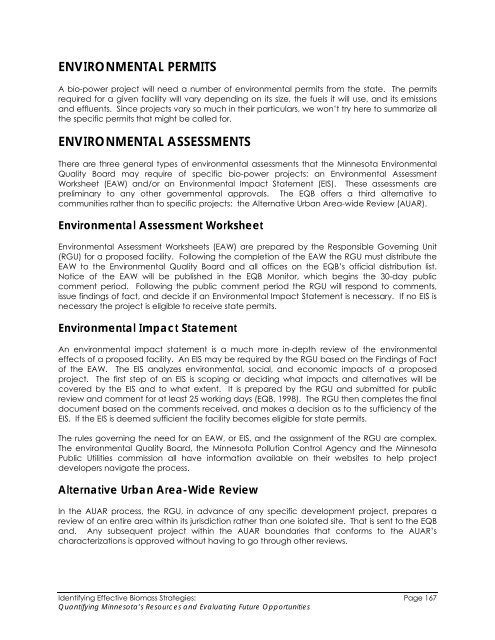Biomass Feasibility Project Final Report - Xcel Energy
Biomass Feasibility Project Final Report - Xcel Energy
Biomass Feasibility Project Final Report - Xcel Energy
You also want an ePaper? Increase the reach of your titles
YUMPU automatically turns print PDFs into web optimized ePapers that Google loves.
ENVIRONMENTAL PERMITS<br />
A bio-power project will need a number of environmental permits from the state. The permits<br />
required for a given facility will vary depending on its size, the fuels it will use, and its emissions<br />
and effluents. Since projects vary so much in their particulars, we won’t try here to summarize all<br />
the specific permits that might be called for.<br />
ENVIRONMENTAL ASSESSMENTS<br />
There are three general types of environmental assessments that the Minnesota Environmental<br />
Quality Board may require of specific bio-power projects: an Environmental Assessment<br />
Worksheet (EAW) and/or an Environmental Impact Statement (EIS). These assessments are<br />
preliminary to any other governmental approvals. The EQB offers a third alternative to<br />
communities rather than to specific projects: the Alternative Urban Area-wide Review (AUAR).<br />
Environmental Assessment Worksheet<br />
Environmental Assessment Worksheets (EAW) are prepared by the Responsible Governing Unit<br />
(RGU) for a proposed facility. Following the completion of the EAW the RGU must distribute the<br />
EAW to the Environmental Quality Board and all offices on the EQB’s official distribution list.<br />
Notice of the EAW will be published in the EQB Monitor, which begins the 30-day public<br />
comment period. Following the public comment period the RGU will respond to comments,<br />
issue findings of fact, and decide if an Environmental Impact Statement is necessary. If no EIS is<br />
necessary the project is eligible to receive state permits.<br />
Environmental Impact Statement<br />
An environmental impact statement is a much more in-depth review of the environmental<br />
effects of a proposed facility. An EIS may be required by the RGU based on the Findings of Fact<br />
of the EAW. The EIS analyzes environmental, social, and economic impacts of a proposed<br />
project. The first step of an EIS is scoping or deciding what impacts and alternatives will be<br />
covered by the EIS and to what extent. It is prepared by the RGU and submitted for public<br />
review and comment for at least 25 working days (EQB, 1998). The RGU then completes the final<br />
document based on the comments received, and makes a decision as to the sufficiency of the<br />
EIS. If the EIS is deemed sufficient the facility becomes eligible for state permits.<br />
The rules governing the need for an EAW, or EIS, and the assignment of the RGU are complex.<br />
The environmental Quality Board, the Minnesota Pollution Control Agency and the Minnesota<br />
Public Utilities commission all have information available on their websites to help project<br />
developers navigate the process.<br />
Alternative Urban Area-Wide Review<br />
In the AUAR process, the RGU, in advance of any specific development project, prepares a<br />
review of an entire area within its jurisdiction rather than one isolated site. That is sent to the EQB<br />
and. Any subsequent project within the AUAR boundaries that conforms to the AUAR’s<br />
characterizations is approved without having to go through other reviews.<br />
Identifying Effective <strong>Biomass</strong> Strategies: Page 167<br />
Quantifying Minnesota’s Resources and Evaluating Future Opportunities

















